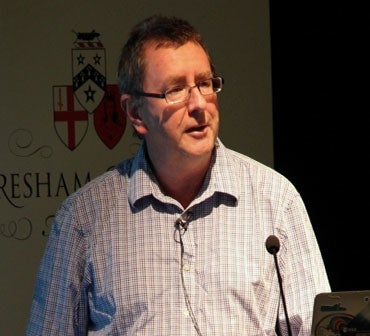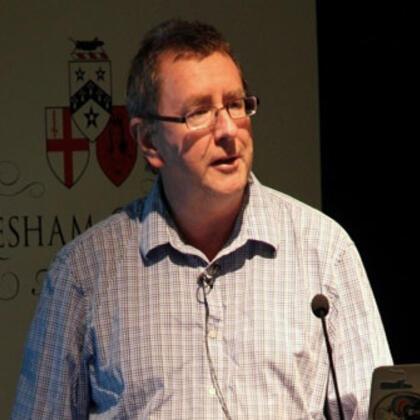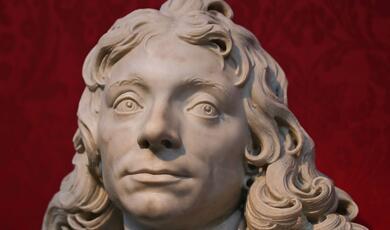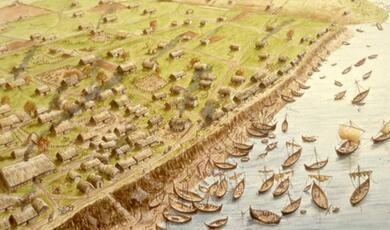Rosetta: Unlocking Secrets from Ancient Egypt to a Comet
Share
- Details
- Transcript
- Audio
- Downloads
- Extra Reading
Just as the Rosetta Stone and the Philae Obelisk became the key to interpreting hieroglyphs and understanding ancient Egyptian civilisation, the European Space Agency’s Rosetta probe and its Philae lander are key to furthering our understanding of the formation of our solar system, and the origins of life. The Philae lander made the first ever soft landing on a comet, opening a new chapter in Solar System exploration.
The Egyptian theme was also used by Professor Colin Pillinger who named the instrument he proposed for the mission Ptolemy. Ptolemy will perform an on-the-spot analysis of the composition of the ices and organic material within the comet. The instrument has already been working in space, making measurements during an asteroid fly-by en route to its cometary destination. The orbiter will continue to follow the comet around the Sun and as it moves back out towards the orbit of Jupiter.
The roles of Thomas Young and Jean-Francois Champollion in deciphering the Rosetta Stone and the contribution of William Bankes with regard to the Philae Obelisk continue to provoke much discussion and will be considered alongside latest results from the spacecraft and instruments which have carried the names far into space.
This is a special Memorial Lecture, held in memory of Professor Colin Pillinger CBE FRS (1943-2014) who was Gresham Professor of Astronomy from 1996 to 2000.
Download Transcript
26 February 2015
Rosetta: Unlocking Secrets from Ancient Egypt to a Comet
Dr Matt Taylor
Professor Richard Parkinson
Professor Ian Wright
Lecture held in memory of Professor Colin Pillinger CBE FRS (1943-2014) who was Gresham Professor of Astronomy from 1996 to 2000.
Professor Colin Pillinger CBE FRS (1943-2014) was Gresham Professor of Astronomy from 1996 to 2000. His first postdoctoral position was analysing the returned Apollo moon samples. He moved from Bristol to the Open University by way of Cambridge, building up an increasingly large research group carrying out world class science. In the 1980s he had a leading role in the proposed mission to return cometary samples for laboratory study – a mission named Rosetta aiming to unlock the secrets of the solar system just as the Rosetta Stone led to our understanding of hieroglyphs. When the European Space Agency mission lost the return element, Colin’s response was to set about shrinking and space-flight qualifying his laboratory analytical instruments to conduct the analyses in situ on the comet. His team leads the UK instrument Ptolemy, situated on the Philae lander of the Rosetta spacecraft. Rosetta was launched in 2004, is now in orbit around its destination and Philae is scheduled to land on the comet’s nucleus this November. Colin was Principle Investigator for Ptolemy, passing the role to his deputy Ian Wright as the Beagle 2 Mars lander demanded his complete commitment. Colin eagerly awaited Philae’s landing and was giving scientific lectures and outreach talks, delighting in talking about the roles of Young, Champollion, Bankes and others, the links between the Rosetta Stone and the Philae obelisk and how his instrument would help understand the nature of comets.
Introduction
Just as the Rosetta Stone and the Philae Obelisk became the key to interpreting hieroglyphs and understanding ancient Egyptian civilisation, the European Space Agency’s Rosetta probe and its Philae lander are key to furthering our understanding of the formation of our solar system, and the origins of life. The Philae lander made the first ever soft landing on a comet, opening a new chapter in Solar System exploration.
The Egyptian theme was also used by ProfessorColin Pillinger who named the instrument he proposed for the mission Ptolemy. Ptolemy will perform an on-the-spot analysis of the composition of the ices and organic material within the comet. The instrument has already been working in space, making measurements during an asteroid fly-by en route to its cometary destination. The orbiter will continue to follow the comet around the Sun and as it moves back out towards the orbit of Jupiter.
The roles of Thomas Young and Jean-Francois Champollion in deciphering the Rosetta Stone and the contribution of William Bankes with regard to the Philae Obelisk continue to provoke much discussion and will be considered alongside latest results from the spacecraft and instruments which have carried thesenames far into space.
Chairman and Speakers
Dr Matt Tayloris Project Scientist for the ESA (European Space Agency) Rosetta mission based at the ESA technical centre in the Netherlands. He was born in London, gained his undergraduate Physics degree at the University of Liverpool, and a PhD from Imperial College London. His career has focused on the space plasma measurements, working in Europe and the US on the four spacecraft ESA Cluster missions, leading to a post at ESA which started in 2005 working as the project scientist for Cluster and the ESA-China Double star mission.
Professor Richard Parkinsonis Professor of Egyptology in the Faculty of Oriental Studies, University of Oxford, Director of the Griffith Institute and Fellow of The Queen’s College. He was formerly curator at the British Museum responsible for the care, research, publication and display of the collection’s papyri, as well as hieratic and hieroglyphic texts, inscribed materials including the Rosetta Stone. In 1999-2000 he curated, Cracking Codes: The Rosetta Stone and Decipherment (Rosetta Stone bicentenary exhibition).
Professor Ian WrightChairman for the Eventis the principal investigatorfor the Ptolemy instrument of the Philae lander. Prior to this he was head of Planetary Sciences at the Open University.
Dr Matt Taylor
The Rosetta mission
The Rosetta Mission is the third cornerstone mission of the ESA programme Horizon 2000. The aim of the mission is to map the comet 67-P/Churyumov-Gerasimenko by remote sensing, to examine its environment insitu and its evolution in the inner solar system. The lander Philae is the first device to land on a comet and perform in-situ science on the surface. Launched in March 2004 and after a number of gravity assists and various asteroid fly –bys, the spacecraft entered deep space hibernation in June 2011. Nearly 10 years after launch on 20th January 2014 at 10:00 UTC the spacecraft woke up from hibernation, and subsequently successfully entered into orbit around the comet and deployed Philae to the surface.
The Rosetta mission is set to re-write the books on cometary science, giving us an unprecedented insight into how these bodies are connected to the origins of the solar system and how it evolved to how we know it today.
Rosetta is the European Space Agency’s comet-chasing mission to 67P/Churyumov-Gerasimenko. Launched on 2 March 2004 the spacecraft travelled for 10 years before homing in on its destination, requiring three vital gravity assist flybys at Earth and one at Mars to set course with the comet. Rosetta is the first spacecraft to rendezvous with a comet and the first to deploy a lander on the surface of a comet nucleus. While previous comet missions have only spent fleeting moments flying past their targets at high velocity, Rosetta ia the first spacecraft to fly alongside a comet as it heads towards the inner Solar System, watching how its ices are transformed by the warmth of the Sun. Rosetta will then continue to follow the comet for several months beyond its closest approach to the Sun, watching how the comet’s activity subsides again.
The Rosetta mission was named after the famous Rosetta stone thatalmost 200 years ago,led to the deciphering of Egyptian hieroglyphics. Rosetta’s lander Philae is named for the island in the River Nile on which an obelisk was found that had a bilingual inscription that enabled the hieroglyphs of the Rosetta Stone to be deciphered. Scientists hope that by studying a comet close up and for an extended period of time, the comet-chasing spacecraft by the same name will unlock the mysteries of how the Solar System evolved.
Comets are considered the most primitive building blocks of our cosmic neighbourhood, surviving the Solar System’s chaotic 4.6 billion year history. Laced with ice and organic materials, cometsprobablyhelped ‘seed’ the Earth with water, and maybe even the ingredients for life. As such, comets are considered the Rosetta Stones of the Solar System, and ESA’s Rosetta mission is set to unlock the secrets of these icy treasure chests.
Rosetta’s mission has its roots buried in the legacy of “Giotto”, ESA’s first deep space mission, which sent back the closest images ever of a comet nucleus, from a distance of about 600 km. Despite taking heavy hits from comet dust, Giotto went on to fly by Grigg-Skjellerup in 1992. As such, Giotto was also the first deep-space mission to change orbit by retuning to Earth for a gravity-assist manoeuvre.
After a 14-month launch delay that led to the mission’s destination being changed from comet 46P/Wirtanen to 67P/Churyumov-Gerasimenko, Rosetta finally launched on 2 March 2004 on an Ariane-5 G+ from Europe’s spaceport in Kourou, French Guiana.
Comet 67P/Churyumov-Gerasimenko is a regular visitor to the inner Solar System. It orbits the Sun once every 6.5 years, commuting between the orbits of Jupiter and Earth – its closest distance to the Sun is 185 million kilometres (by comparison, Earth is about 150 million kilometres from the Sun). The comet was first observed from Earth in 1969 – Klim Churyumov discovered the comet in a photograph taken by Svetlana Gerasimenko, giving rise to its name. The 67P indicates that it was the 67th short period (P) comet discovered.
To get to this target, Rosetta exploited the gravity of Earth and Mars to set course with the comet. Thus for the first half of its journey Rosetta played a game of cosmic pinball, first getting a boost from Earth’s gravity on 4 March 2005, then Mars on 25 February 2007, before bouncing back to Earth on 13 November 2007 and again in 13 November 2009. Along the way, Rosetta delved twice into the Solar System’s asteroid belt, taking the opportunity to return spectacular close-up images and perform scientific analysis of two previously uncharted bodies: asteroid 2867 Steins on 5 September 2008, and 21 Lutetia on 10 July 2010.
Rosetta travelled far away from the Sun, such that solar energy was not enough to support the platform completely and entered into hibernation on 8 June 2011 for the coldest leg of its journey as it headed towards the orbit of Jupiter. All systems were switched off except for the thermal control and onboard computer, powered only by the solar panels. On 20 January 2014, 957 days later, the spacecraft autonomously woke up from hibernation, 9 millionkilometres from the comet. The next months were spent closing in on the comet, eventually entering a 10 km orbit and mapping it for landing. On 12 November 2014, Rosetta deployed Philae to the surface. The Philaesuccessfully landed, bounced,and finally came to rest on the surface around 1 km from the original landing site.
The Rosetta mission is set to re-write the books on Cometary science. Currently funded until end of 2015, we hope to extend the mission into 2016, until the spacecraft and comet move away from the Sun so that power becomes an issue again.
© Dr Matt Taylor, February 2015
Professor Richard Parkinson
The Rosetta Stone
The Rosetta Stone was the key to the decipherment of hieroglyphs. The inscription on it is a decree passed by a council of priests, affirming the royal cult of the boy-king Ptolemy V on the first anniversary of his coronation. It was carved in a period when Egypt was ruled by kings of Greek descent, and so the decree is inscribed on the stone three times, in hieroglyphic script (the traditional script of Egyptian culture), demotic (the Egyptian script used for daily purposes), and Greek (the language of the administration).
Soon after the end of the fourth century AD, when hieroglyphs had gone out of use, the knowledge of how to read and write them disappeared. In summer 1799, soldiers in Napoleon's army discovered the Rosetta Stone in while digging the foundations of an addition to a fort near the town of el-Rashid (Rosetta). On Napoleon's defeat, the stone became the property of the British under the terms of the Treaty of Alexandria (1801), and scholars were able to use the Greek inscription in their struggle to decipher hieroglyphs.
Thomas Young, an English physicist, was the first to show that some of the hieroglyphs on the Rosetta Stone wrote the sounds of a royal name, that of Ptolemy. Using this and other inscriptions, including an inscription on an obelisk from Philae, the French scholar Jean-François Champollion then realized that hieroglyphs recorded the sound of the Egyptian language and laid the foundations of our knowledge of ancient Egyptian language and written culture.
The Rosetta Stone has been exhibited in the British Museum since 1802 and has become an icon of humanity’s attempts to decipher languages and cultures. In 1999, the bicentenary of its discovery was celebrated with an exhibition ‘Cracking Codes: The Rosetta Stone and Decipherment’, which included a model of the Rosetta space probe.
© Professor Richard Parkinson, February 2015
Selected References
http://www.britishmuseum.org/explore/highlights/highlight_objects/aes/t/the_rosetta_stone.aspx.
R. B. Parkinson, Cracking Codes: The Rosetta Stone and Decipherment. (London: British Museum Press 1999).
R. B. Parkinson, The Rosetta Stone (Objects in Focus; London: British Museum Press 2005).
This event was on Thu, 26 Feb 2015
Support Gresham
Gresham College has offered an outstanding education to the public free of charge for over 400 years. Today, Gresham plays an important role in fostering a love of learning and a greater understanding of ourselves and the world around us. Your donation will help to widen our reach and to broaden our audience, allowing more people to benefit from a high-quality education from some of the brightest minds.


 Login
Login











